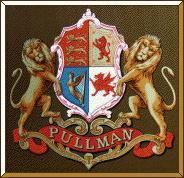 "Rebecca " A
1/8th Scale S.R. Pullman Car
"Rebecca " A
1/8th Scale S.R. Pullman CarWORTLEY TOP FORGE MODEL ENGINEERS
 "Rebecca " A
1/8th Scale S.R. Pullman Car
"Rebecca " A
1/8th Scale S.R. Pullman Car
PART III
INTERIOR
Doors and windows were made up from clear acetate sheet as sold by B & Q and similar DIY chains. Wooden frames and window sections were then glued on having been cut to size from thin ply strip and, in common with the rest of the interior woodwork, given several coats of woodstain and varnish. Brass door handles were then fitted - these being fairly elegant and therefore purchased from the local dolls house supplier. The famous marquetry pictures which summed up the Pullman elegance were glued onto the finished walls. I took close-up photographs from a restored Pullman on the Bluebell Railway and, with the aid of the PC, managed to reduce them to the right size and print them off. The Kitchen cupboards and units were made from stainless steel sheet with pop rivets to represent handles, knobs etc. Dolls house paper was used to represent typical kitchen linoleum and the whole area was filled with pots, pans, foodstuffs and tools to represent a crowded and busy working environment.
The final touch was to supply a chef which was made up from head and limbs from the local dolls house supplier bound together with pipe cleaners, tissue and bandage. Major concessions here were the use of plain glass in the window - if I’d used the prototypical frosted glass, I could have saved a fortune on the interior trimmings, but it wouldn’t have looked as interesting! The other was the absence of a stove or source of heating, so perhaps the clientele were all salad aficionados, though those eggs frying away will never get done!
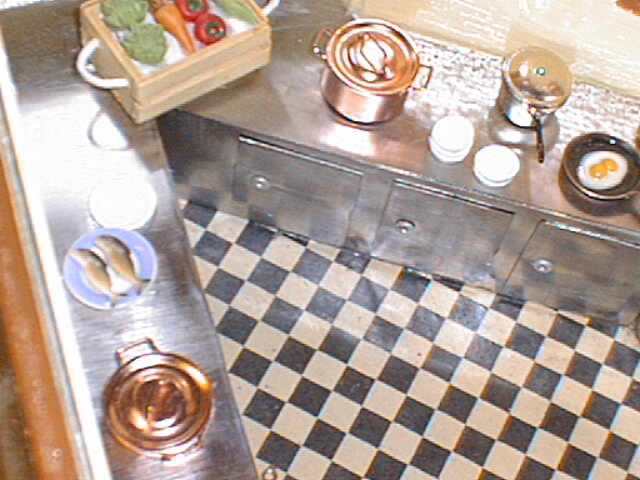 The
kitchen
The
kitchen 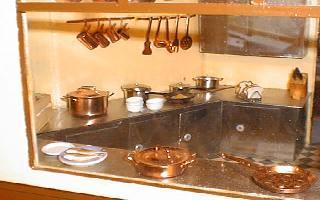
The Main Saloons and Coupe Dolls house carpet material was carefully cut to size and stuck to the three main floor areas, two saloons and the coupe. Individual armchairs were modelled from MDF based on photographs of “the real thing” and were upholstered using some redundant but ideal curtain material scrounged from my Mother! The same material was used to form tiny napkins. Anti-mocassars were added from the same white sheet which was used to provide tablecloths on the plywood tables. A full place setting of cutlery, chinaware, wine glasses for each passenger was glued to the tables and a vase of roses placed on each. The tableware was again sourced from dolls house suppliers, but the floral decorations were fashioned from a drinking straw, covered in kitchen foil and flowers from wedding cake decorations inserted.
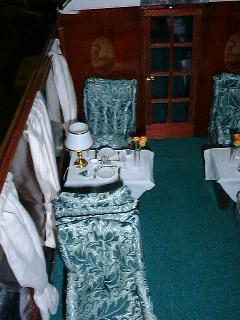 Saloon Interiors
Saloon Interiors
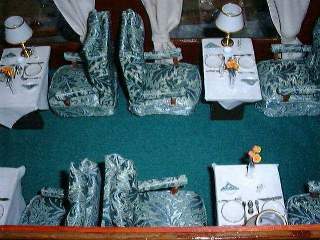
The coupe was equipped with an ornate mirror on the corner wall. The working table lamps were originally going to be fashioned on my Boxford - although how I’d make the lampshades I hadn’t worked out! The problem was solved on my next birthday when I was presented with a full set of table lamps all wired up and ready to be installed. Wiring was run through the floor from each table and connected to a common 12v dc bus running beneath the floor and terminating in connectors at each end of the coach. The idea here was that electrical supplies would come either from a small 12v battery hidden in the toilet or pantry when the coach was operating in isolation, or from the main traction battery of the 2-BIL unit when running in EMU formation.
.
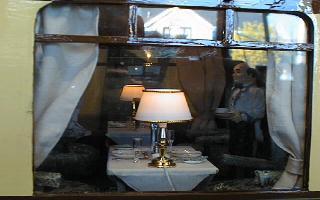
PAINTING After several coats of undercoat, the gloss top coats of umber and cream were applied, with each coat being rubbed down well. Mason's commercial transport paints were obtained from a contact in the trade and are superb.
TRANSFERS The whole project has taken around eighteen months to
complete, and from day one I knew what the worst problem was going to be: those
transfers! Not just the Pullman crests, but the ornate name panels and the
lining. Oh boy, was I right! It seems that nobody
in the marketplace does Pullman transfers in 1/8th scale and I even started to
think about professional signwriters!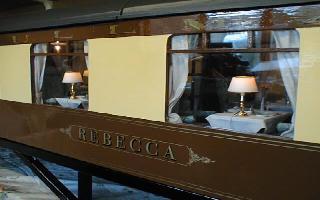 A chance scan through the Society
journal of the 7¼" Gauge Society revealed an advertisement for Eastwood
Carriage and Wagon Works which included pictures of some Pullman Cars, an EMAIL
address and a website! The website couldn't be accessed but I was able to
contact Brian Baker of Eastwood C&W by EMAIL. Brian was unable to sell any
of his transfers which are made up to a special order and needed for his
commercial Pullman cars. He did, however, admit to having problems with his
website, and after some very friendly bartering, I was able to sort out his
site in exchange for sufficient spare transfers to solve my
problem!
A chance scan through the Society
journal of the 7¼" Gauge Society revealed an advertisement for Eastwood
Carriage and Wagon Works which included pictures of some Pullman Cars, an EMAIL
address and a website! The website couldn't be accessed but I was able to
contact Brian Baker of Eastwood C&W by EMAIL. Brian was unable to sell any
of his transfers which are made up to a special order and needed for his
commercial Pullman cars. He did, however, admit to having problems with his
website, and after some very friendly bartering, I was able to sort out his
site in exchange for sufficient spare transfers to solve my
problem!
So why "Rebecca"? Well, being an old romantic, I decided originally to name the car "Rita" after my wife - and it was a genuine car which regularly ran to and from Eastbourne in my boyhood trainspotting days. This idea was quickly quashed by the lady herself - who, incidentally, had surprised me on my 21st birthday with two tickets for dinner on the Brighton Belle on evening in 1968. "Why not call it after the coach we went on then" she suggested! This was an excellent idea - it also meant I could still name it after her - the car concerned was "Mona"!
Unfortunately, this was one of the names which Brian Baker couldn't provide. He did, however, have "Rebecca" which just happened to be the name of my new-born grand-daughter. So that sealed it; "Rebecca" it was to be.
CONCLUSION
I must confess that I really enjoyed building the car, and tackling the many detailed problems encountered on the way. I even managed to smile at the many jibes from fellow members of Wortley Top Forge Model Engineers who keep referring to it as "the Dolls House on wheels"! Perhaps the highlight was when I was asked to exhibit "Rebecca" at the 2001 Harrogate Model Engineering Exhibition. No it didn't win any prizes, but the continuous attention from the ladies and their determination to make 'the old man make me one like that when we get home' made me smile - I bet there were some interesting domestic discussions as a result!
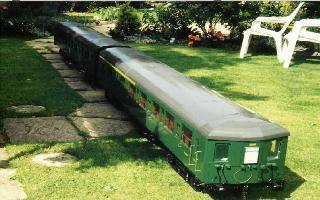 The 2-BIL now awaits its
centre car to become a 3-PUL?
The 2-BIL now awaits its
centre car to become a 3-PUL?